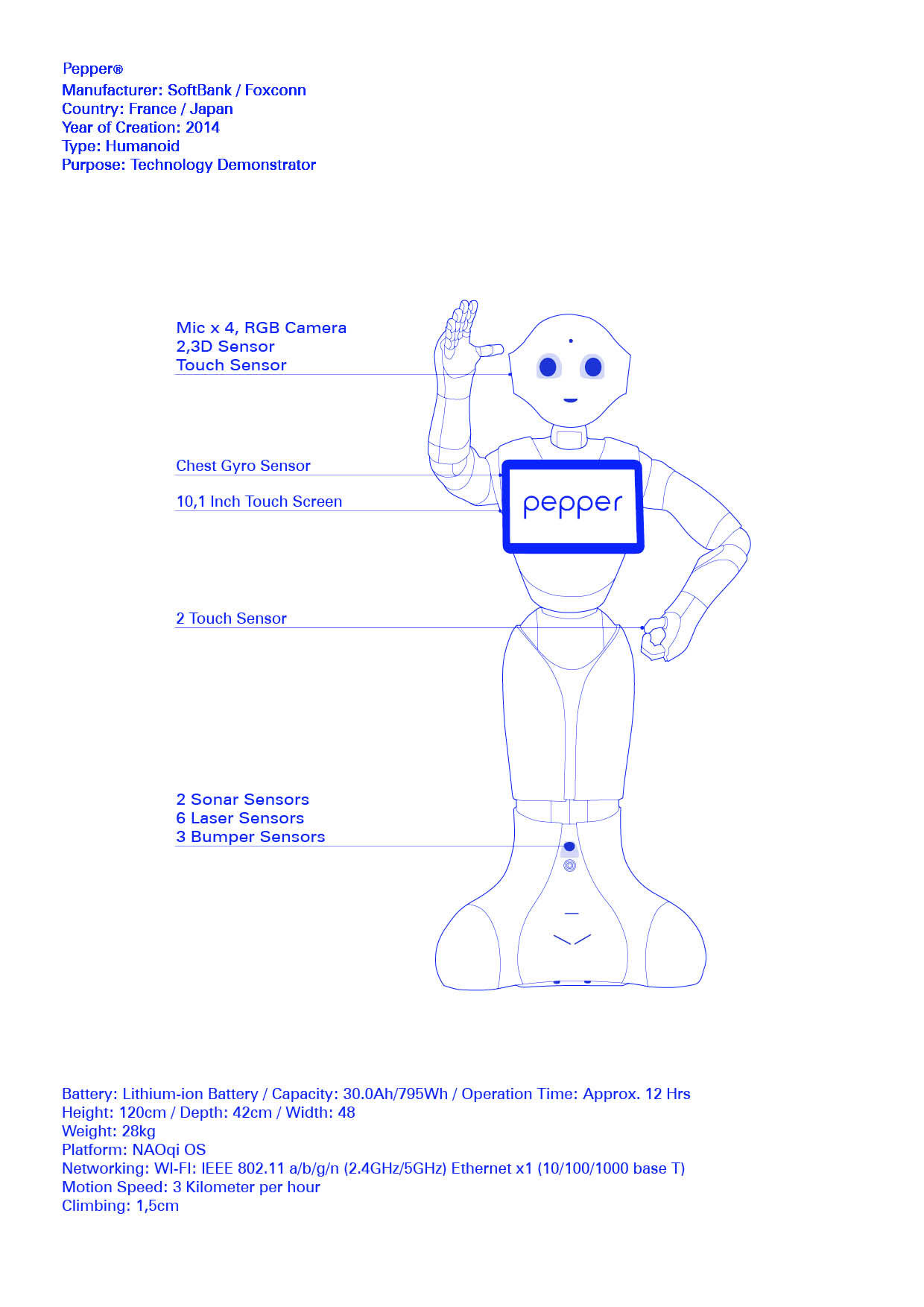
Pepper®
Concrete object, High-Tech, Consumption, Object, World War, Automation, Technology, Economy, Commercial, Drawing
Manufactured by SoftBank Robotics, Pepper was first introduced in 2014. A semi-humanoid robot with the ability to read emotions through expressions and voice data recording. Often used in hospitality, pepper sells at the price of 1.600 dollars, by 2018, 12.000 units were sold in Europe alone. Working at restaurants, offices, hotels, medical facilities and even airports, this robot is slowly making his way into people’s homes, although it had some problems to accomplish certain tasks.1
Japan has a long relationship with robots that according to Professor Hirofumi Katsuno, initiated after World War II, Japan promoted a peaceful use of science and technology, in that process anime and manga creators took inspiration to portray the coexistence between humans and robots.2 Pepper is part of the ongoing image of these humanoid robots that take morphologic qualities from anime or even children, to appear as harmless and endearing as they can.
Both in the Miraikan Museum in Tokyo or the cité des sciences et de l'industrie of Paris, the robots found could be classified in four: 1. The stuffed animal: resembling dogs, penguins or seals, these robots are for home company. 2. The Humanoid: Like Pepper, hospitality is their main function. 3. The Android: robots who mimic the human body and features. And 4. The machine: Mechanical arms of industrial use. The Aforementioned institutions introduce these robotic technologies to society and allow for children to get acquainted with these inventions and their mechanics.
Robots like Pepper are preluded by Automaton, their principles of mechanization for self-operation are inspired in Automata such as those designed by Jacques de Vaucanson or the Japanese Karakuri puppets,3 although these didn’t need the large amounts of electricity that Pepper needs today.
1. https://www.softbankrobotics.com/us/pepper
2. Meet the robots powering Japan new tech movement, Bloomberg, 2016.
3. Gaby Wood, Living Dolls: A Magical History Of The Quest For Mechanical Life by Gaby Wood, The Guardian, 2002.
Concrete object, High-Tech, Consumption, Object, World War, Automation, Technology, Economy, Commercial, Drawing
Manufactured by SoftBank Robotics, Pepper was first introduced in 2014. A semi-humanoid robot with the ability to read emotions through expressions and voice data recording. Often used in hospitality, pepper sells at the price of 1.600 dollars, by 2018, 12.000 units were sold in Europe alone. Working at restaurants, offices, hotels, medical facilities and even airports, this robot is slowly making his way into people’s homes, although it had some problems to accomplish certain tasks.1
Japan has a long relationship with robots that according to Professor Hirofumi Katsuno, initiated after World War II, Japan promoted a peaceful use of science and technology, in that process anime and manga creators took inspiration to portray the coexistence between humans and robots.2 Pepper is part of the ongoing image of these humanoid robots that take morphologic qualities from anime or even children, to appear as harmless and endearing as they can.
Both in the Miraikan Museum in Tokyo or the cité des sciences et de l'industrie of Paris, the robots found could be classified in four: 1. The stuffed animal: resembling dogs, penguins or seals, these robots are for home company. 2. The Humanoid: Like Pepper, hospitality is their main function. 3. The Android: robots who mimic the human body and features. And 4. The machine: Mechanical arms of industrial use. The Aforementioned institutions introduce these robotic technologies to society and allow for children to get acquainted with these inventions and their mechanics.
Robots like Pepper are preluded by Automaton, their principles of mechanization for self-operation are inspired in Automata such as those designed by Jacques de Vaucanson or the Japanese Karakuri puppets,3 although these didn’t need the large amounts of electricity that Pepper needs today.
1. https://www.softbankrobotics.com/us/pepper
2. Meet the robots powering Japan new tech movement, Bloomberg, 2016.
3. Gaby Wood, Living Dolls: A Magical History Of The Quest For Mechanical Life by Gaby Wood, The Guardian, 2002.


